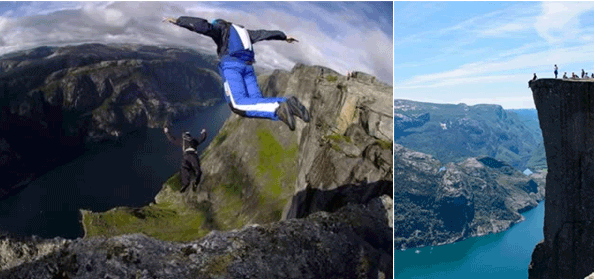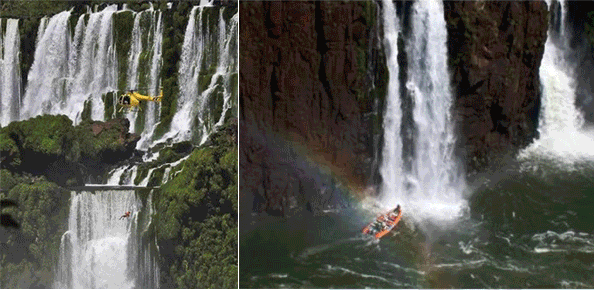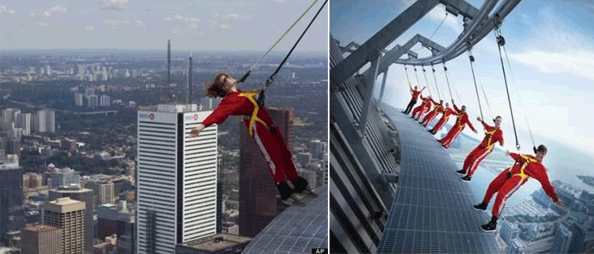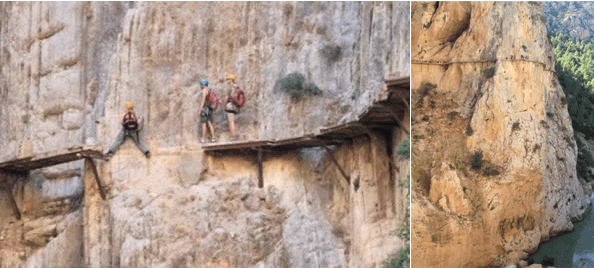|
Extreme tourism or shock tourism is a niche in the
tourism industry involving travel to dangerous places (mountains,
jungles, deserts, caves, etc.) or participation in dangerous events.
Extreme tourism overlaps with extreme sport. The two share the main
attraction, "adrenaline rush" caused by an element of risk, and
differing mostly in the degree of engagement and professionalism.
|
|
The Cage of Death (Australia)
Without the cage you wouldn't stand a chance swimming with a massive
saltwater crocodile. But for brave punters who still want to get cozy
with a feisty croc, a new Australian tourist attraction is offering the
chance for a close encounter in the safety of a clear acrylic box dubbed
the 'cage of death.'
Just 4cm of acrylic, a pair of goggles and a swimsuit, separate thrill
seekers from the jaws of Choppa, a saltwater crocodile. The cage has no
bars, unlike cages used in shark dives, which prevent the reptiles from
gripping on, but deep tooth scratches are visible on the sides,
deterring some hesitant participants. Top End tourists climb into the
clear box before being lowered into Choppa's lair. They then spend 15
minutes inside the 9ft high cage and watch Choppa, who lost both front
feet while fighting other crocodiles, try to take a bite out of them.
The attraction at Crocosaurus Cove, in the heart of the city of Darwin
in the Northern Territory, has been given high marks by adrenaline
junkies.
|
|
 |
|
Cliff Base Jumping (Norway)
Norway has absolutely beautiful landscapes, including crazy cliffs that
call to people to climb them and then BASE jump off the top. Here's a
look at some of those incredible cliffs, as well as some insanely
dangerous switchback roads to get to them in Norway. Thrill seekers,
photographers, hikers and climbers take in these majestic views of
nature. And then, there's BASE jumpers who have a much more extreme need
for adrenaline. Charles Lindbergh once said of his adrenaline rush, “It
is the greatest shot of adrenaline to be doing what you have wanted to
do so badly. You almost feel like you could fly without the plane.” Here
in Norway, as if they've turned into Superman, some adrenaline junkies
do fly without a plane.
|
|

|
|
Iguazu Boat Ride (Argentina & Brazil)
Taller than Niagara Falls and twice as wide, the Iguazu cataracts are
one of the most impressive sites that you will ever see in your travels
around the world. 275 waterfalls cascade through the Argentine and
Brazilian parks and once you see the Devil's Throat you won't regret the
trip.
For 15 USD you can take an Iguazu boat ride that will allow you to thumb
your nose at the visitors in both countries, as you motor right into the
fury of the monstruous falls. Not only will you get absolutely soaked
and feel, up close, the power of the falls, but you also get bragging
rights, because no matter how you phrase it, the fact that you took a
small boat and motored into the dump zone to receive a sheet of water
from some of the biggest falls in the world, is undeniably sweet.
Note: In 2011, two US tourists were killed and five people were injured
when one of the boats overturned. Seven tourists from the US, Germany
and Colombia were sightseeing at Iguazu Falls in northern Argentina with
a crew of three when their boat hit rocks and flipped over.
|
|

|
|
CN Tower Edge Walking (Toronto, Canada)
The CN Tower holds a Guinness World Record for its EdgeWalk attraction —
the highest external walk on a building. The attraction allows people to
walk hands free along a 1.5-metre-wide ledge that surrounds the top of
the tower's main pod.
Walkers who venture out in groups of six are secured with a harness
during their 150-metre stroll. The walk opened to the public on Aug. 1
2011 and officials say it has attracted thrill seekers from age 13 to
90.
|
|

|
|
El Caminito Del Rey Trekking (Spain)
Adrenaline junkies have been flocking to southern Spain to experience
the 110-year-old El Caminito Del Rey. And you don't need to be an
experienced climber either; the only requirements are that walkers
should be at least twelve years old and have a good head for heights.
The trail, also known as the King's Pathway, was originally built in
1905 for workers to travel between two hydroelectric power plants but
was closed-off in 2000 after two walkers fell to their deaths.
|
|
 |
| |
|
|